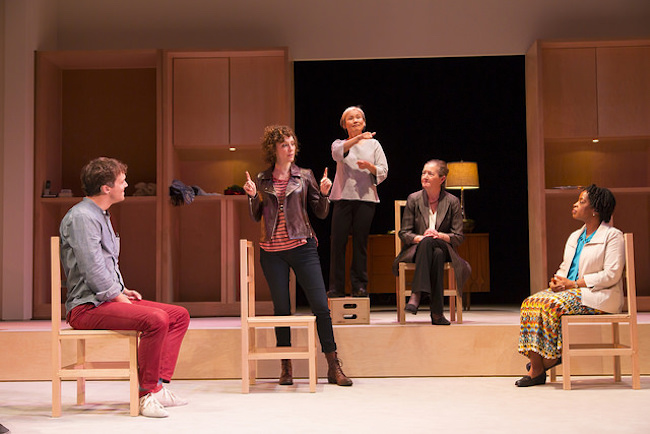Theater Review: “I Was Most Alive With You” — Ambition is Not Enough
The effort to merge Deaf culture with the Book of Job becomes too much a burden for Craig Lucas’s family melodrama to bear.
I Was Most Alive With You, written and directed by Craig Lucas. Staged by the Huntington Theatre Company at the Calderwood Pavilion at the Boston Center for the Arts, Boston, MA, through June 26.

Russell Harvard and Nancy E. Carroll in the Huntington Theatre Company production of “I Was Most Alive With You.” Photo: T Charles Erickson.
By Joann Green Breuer
Craig Lucas, graduate of Boston University, author of Prelude to a Kiss and Reckless, among other plays, certainly has an idea for his new play I Was Most Alive with You.
The problem is, he is enamored of too many ideas. A few, in alphabetical order, using only the initial letter of the alphabet:
abandonment
accessibility
addiction
adoption
affliction
alcoholism
American Sign Language
amputation
atheism
attraction
A general rule: one should avoid trying to create an important work. The effort usually appears strained, an obvious and unsatisfying endeavor. Lucas attempts to merge Deaf culture with the Book of Job here, and the weight of significance is often too much a burden for this family (melo)drama to bear gracefully (pun intended). The dramatist’s intention is admirable. The presentation of a dual American Sign Language (ASL)/English drama can be enlightening, and exhilarating, challenging eye, ear, and consciousness. Communication is the sine qua non of human life. In his production, on occasion, Lucas achieves a measure of communication’s essential potential.
A few words about ASL: First and foremost, it is a distinct language. Its vocabulary is at times culturally related to American social and metaphorical consensus, as other sign languages’ vocabulary is at times culturally related to their countries of origin. It is not the same as English Sign Language, let alone Signed English (see below). ASL is not mimed iconography, although iconic symbolism can appear. Nor is it limited in expression of connotation and tone. Its structure is visual, often wrongly seeming attenuated in comparison with spoken English. One moving ASL gesture can contain a formal, academic conjugation. Grammar and semantics are incorporated through hand shape, placement of hands, speed/stops and direction of arm and hand movement, and facial and corporal gesture. It can be poetic in rhythm and movement, and as vulgarly colourful as we humans need. It has its own phrase order, which is not the same as that of spoken English.
Signed English uses ASL word signs, but follows the grammatical structure and word by word order of spoken English. The request in the play not to speak and sign at the same time is proper, the incompatible equivalent of patting ones head and rubbing ones stomach simultaneously. Attentive audience, members watching speaking characters who are new to signing ASL will note the difference in comfort and fluency as shadow interpreters interpret that dialogue. Characters continue to translate English words. ASL conjures a difference in both conception and reception from Signed English – but the Deaf (in the play as in the world) are patient, tolerant, and appreciative of all endeavors, (thankfully says this reviewer, a perpetual ASL neophyte).
Craig Lucas uses several methods of making I Was Most Alive With You accessible to hearing, deaf, and Deaf audiences. Deaf, capital D, represents those who are comfortable in ASL language and culture, whereas deaf, small d, denotes a physical condition. The shadow interpreters for each character are parallel performers, often mimics, at rare times clearer glimpses of characters’ inner life. Interpreters for each character move or remain near that speaking character, or at a distance in a mirrored scene. As stated, characters do at times speak and sign simultaneously, which serves the dual purpose of exploration of dramatic intention as well as comprehension by all, other characters and audience. These choices are valid, even if it results in an awkwardly crowded stage. There are also occasional English projections when dialogue is solely in ASL. This variety of interpretations indicates a mélange of possibilities, not all equally effective. I am particularly troubled by the projections. Their artistic utility is questionable, distracting, unimaginative choice – perhaps a last resort. Note: in the bilingual Spring Awakening projections represent what is written in school notebooks, an appropriate, aesthetic solution.
On to the play itself. The Book of Job, background myth and partial inspiration for I Was Most Alive With You, has been exegetically reaped by rabbis for centuries, including the 21st. The validity and value of using Biblical standard bearers is challenging, as it can overreach or be mired in cliché. When it works, it chills. When it falters, it irks. The problem of why bad things happen to good people remains a predicament. A solution would ensure a way to avoid responsibility for anything bad which happens to any individual, (including, I imagine, to oneself). It would also provide a philosophical GPS route to a good God. To my limited knowledge, no solutions proposed have been universally accepted. What is obvious, however, is that after all the death, disease, pain, poverty, Job chooses to keep trying. He chooses life. Life is, for Job, the ultimate recourse to life’s catastrophes and pleasures. If there is any message in Job, so be it. I leave it to audiences to judge whether Knox, the central Deaf Job figure, or Craig Lucas, his fashioner, conveys the message. The dilemma of I Was Most Alive With You persists: is the Deaf, gay, recovering addict, adoptee Knox, played by the powerhouse actor Russell Harvard (Tribes), a sufficiently acceptable representative for Job, whose pre-suffering life is benevolent and unquestioned? Alternatively, is Knox meant to be the antithesis of Job, able to cope only so far, beset beyond hope? We are, after all, only vulnerable humans, not idealized exemplars.

A scene in the Huntington Theatre Company production of “I Was Most Alive With You.” Photo: T Charles Erickson.
Lucas has chosen to direct his script himself. This choice may have been driven by the playwright’s lack of confidence in either the script or a director. Unfortunately, the result is often redundancy of expression. The playwright feels the need to be sure that whatever he wrote is understood. What is on the surface, the words, are writ in bold, underlined, by the staging. Single level of meaning marginalizes underlying contradictions of emotion and metaphor. Theatre art is at best a collaboration of perceptions. Varied and multiple perceptions, of actor, director, playwright can reveal more than meets the page. Some writers are indeed their own best director: Richard Nelson, Maria Irene Fornes, Robert Wilson, come to my mind. Here, however, pacing stumbles, characters live too long on one note, and focus is compromised, not necessarily by the use of shadow interpreters, but by their placement. Stage movement, or lack of it, as in in the first act extended expository conversation, feels static or random. Characters abandon personae by moving furniture about the space like stage hands. Even the injured Knox pushes a large table, wounds ignored. Dual language theater can be a juggling act. There is the exigency to keep signers facing the audience and unblocked by others, and still keep multiple social connections and psychological implications resonating. Technical skill is the invisible engine of artistic vision. Despite admirable motivation, (and audience esteem), Lucas has not yet mastered that directorial unity.
On to the cast: Full disclosure: I have worked with Dee Nelson. My admiration for her luminescent talent is undimmed. She brings requisite humour and an edge of desperation to her role as Pleasant, ironic though the name is. Nancy E. Carroll as Carla sustains a deep simplicity. There is not a touch of sentimentality in her clearheaded personification. Steven Goldstein spins his family dynamics with paternal vigor. Marianna Bassham, Tad Cooley, and Gaeela Wright, the other speaking actors, give strength to the ensemble and, despite occasional moments of awkward staging, offer Knox reasonable accommodation. Russell Harvard, as Knox, deserves another mention. His magnificent act one riff in full body ASL, accented by visual lyricism and balladry, is an astonishing sensory spectacle. After his injury, when he no longer signs, but speaks, we are profoundly aware of how much is lost.
Not to be left unnoticed are the four shadow interpreters, Joey Caverly, Amelia Hensley, Monique Holt, and Christopher Robinson, who must transmit dialogue, mood, and substance of characters in another language, without overshadowing them. Each interpreter is artistically and linguistically proficient, and several, notably Christopher Robinson, are accomplished actors, delineating their theatrical responsibilities with aplomb.
I Was Almost Alive With You is to be commended for its respect for America Sign Language, and its determination to make an enduring statement about the human condition. In art, regrettably, determination is only a beginning.
Joann Green Breuer is artistic associate of the Vineyard Playhouse.
Tagged: ASL, Book of Job, Craig Lucas, Deaf, Dee Nelson, Huntington Theater Company

I saw the production and would agree with a lot of what Joann Green Breuer says. I would add that Job has a strong dramatic conflict that Lucas doesn’t make use of. (Aside from the isolated, easily dismissed skepticism of Pleasant.) In the story, God has been (inexplicably) tempted into testing the loyalty of the true blue Job: the ‘Devil’ insinuates that Job, his good fortune destroyed, will blaspheme God. In his misery, Job is beset with some fair weather friends — “tempers” of a sort — all of whom hammer away at Job, suggesting that he must have done something wrong, that he is at fault. If only he can come up with where he went wrong. Job withstands the condescending needling (there is an element of black comedy here), which earns him his grand but dismissive response from God. Here is where I may depart a bit from Joann — Job is not about life (unless it is a celebration of the bare minimum — no family, no money, physical torment, no future), but about the human demand for an answer. And Job’s tenacity earns him one — one of the most magnificent speeches in the Bible.